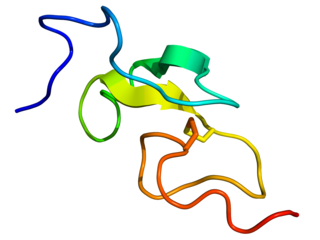Epigen also known as epithelial mitogen is a protein that in humans is encoded by the EPGN gene. [5] [6]
Epigen also known as epithelial mitogen is a protein that in humans is encoded by the EPGN gene. [5] [6]
The protein encoded by this gene is a member of the epidermal growth factor family. Members of this family are ligands for the epidermal growth factor receptor and play a role in cell survival, proliferation and migration. This protein has been reported to have high mitogenic activity but low affinity for its receptor. Expression of this transcript and protein have been reported in cancer specimens of the breast, bladder, and prostate. [5]

Epidermal growth factor (EGF) is a protein that stimulates cell growth and differentiation by binding to its receptor, EGFR. Human EGF is 6-kDa and has 53 amino acid residues and three intramolecular disulfide bonds.

Amphiregulin, also known as AREG, is a protein syntetized as a transmembrane glycoprotein with 252 aminoacids and it is encoded by the AREG gene. in human.

Epiregulin (EPR) is a protein that in humans is encoded by the EREG gene.

The neuromedin B receptor (NMBR), now known as BB1 is a G protein-coupled receptor whose endogenous ligand is neuromedin B. In humans, this protein is encoded by the NMBR gene.

The G protein-coupled bile acid receptor 1 (GPBAR1) also known G-protein coupled receptor 19 (GPCR19), membrane-type receptor for bile acids (M-BAR) or TGR5 as is a protein that in humans is encoded by the GPBAR1 gene.

Cadherin EGF LAG seven-pass G-type receptor 3 is a protein that in humans is encoded by the CELSR3 gene.

Cadherin EGF LAG seven-pass G-type receptor 2 is a protein that in humans is encoded by the CELSR2 gene.

Probable G-protein coupled receptor 75 is a protein that in humans is encoded by the GPR75 gene.

Retinoic acid-induced protein 3 is a protein that in humans is encoded by the GPRC5A gene.

EGF, latrophilin and seven transmembrane domain-containing protein 1 is a latrophilin-like orphan receptor of the adhesion G protein-coupled receptor family. In humans this protein is encoded by the ELTD1 gene. ELTD1 appears to have a role in angiogenesis, both physiological and pathological in cancer.

Teratocarcinoma-derived growth factor 1 is a protein that in humans is encoded by the TDGF1 gene. The protein is an extracellular, membrane-bound signaling protein that plays an essential role in embryonic development and tumor growth. Mutations in this gene are associated with forebrain defects. Pseudogenes of this gene are found on chromosomes 2, 3, 6, 8, 19 and X. Alternate splicing results in multiple transcript variants.

EPH receptor A1 is a protein that in humans is encoded by the EPHA1 gene.

Insulin receptor-related protein is a protein that in humans is encoded by the INSRR gene.

Neuregulin 2, also known as NRG2, is a protein which in humans is encoded by the NRG2 gene.

Mitogen-activated protein kinase 4 is an enzyme that in humans is encoded by the MAPK4 gene.

Epidermal growth factor receptor kinase substrate 8-like protein 2 is an enzyme that in humans is encoded by the EPS8L2 gene.

Epidermal growth factor receptor kinase substrate 8-like protein 3 is an enzyme that in humans is encoded by the EPS8L3 gene.

EPH receptor A10 is a protein in humans that is encoded by the EPHA10 gene.

The KSR2 gene is Kinase suppressor of ras 2 it is a protein that in humans is encoded by the KSR2 gene. KSR2 mutation effects in humans by obesity and because KSR2 gene reduces the ERK signaling and it reduces glucose and fatty acid oxidation. KSR2 mutation reduces the glucose and fatty acid oxidation process but it makes growth factor "Epidermal growth factor (EGF)" reaction more faster to simulate cell growth and KSR2 cause insulin resistance, KSA2 gene also regulates how the body uses the energy, and it usually causes type 2 diabetes.

CKLF like MARVEL transmembrane domain containing 7 is a protein that in humans is encoded by the CMTM7 gene.
This article incorporates text from the United States National Library of Medicine, which is in the public domain.